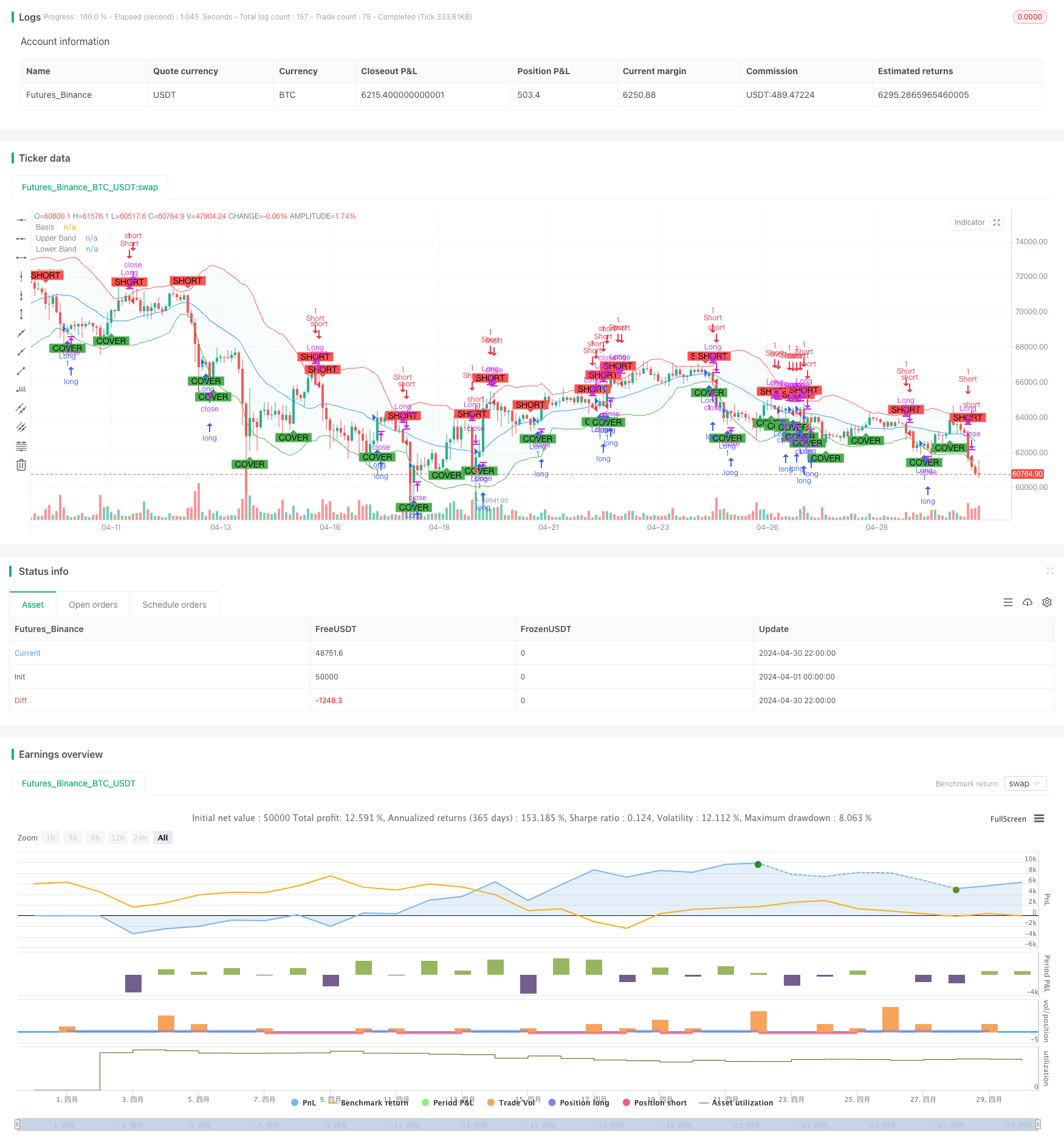
概述
该策略基于布林带指标,通过分析价格相对于上轨、下轨和中轨的运动,识别最佳的买卖机会。策略同时管理多头和空头仓位,允许从各种市场方向中获利。策略参数可定制,以适应不同的风险承受能力和市场方法。策略提供清晰的图表指标和实时的买卖信号提醒。
策略原理
- 当价格上穿下轨或中轨时,生成买入信号,表明可能出现上涨趋势。
- 当价格下穿上轨或中轨时,触发卖出信号,预示可能出现下跌趋势。
- 当价格下穿上轨或中轨时,启动做空信号,允许从下跌的市场中获利。
- 当价格上穿下轨或中轨时,激活平仓信号,提示平掉空头仓位以锁定利润或降低损失。
策略优势
- 基于可靠的技术分析原则,经过严格测试,确保可靠性和有效性。
- 易于在TradingView上实现和定制,适合各种经验水平的交易者。
- 持续提供支持和更新,以适应不断变化的市场条件,保持策略的最佳表现。
- 提供动态的入场和出场点,通过分析相对于布林带上轨、下轨和中轨的价格变动,确保在最有利的时刻进出交易。
- 集成多头和空头仓位管理,无论市场趋势如何,都能从各个方向获利。
策略风险
- 在震荡市场条件下,频繁的交易信号可能导致过度交易和潜在的亏损。
- 策略依赖于历史数据和统计分析,可能无法完全捕捉市场的非理性行为和黑天鹅事件。
- 参数选择不当可能导致策略表现不佳。需要仔细优化和回测参数,以适应特定的市场和交易风格。
- 没有单一策略能在所有市场条件下都表现出色。布林带策略可能在某些情况下表现不佳,因此建议将其与其他指标和风险管理技术相结合。
策略优化方向
- 加入更多指标的组合逻辑来标识更可靠的交易信号,例如RSI、MACD等。这有助于过滤噪音并减少误报。
- 考虑引入自适应波动性计算,根据市场状况动态调整布林带的宽度。这可以更好地捕捉不同波动率环境下的机会。
- 实施基于ATR或百分比的止损和止盈机制,以更好地管理风险和保护利润。这有助于限制潜在损失并锁定已实现收益。
- 探索基于市场周期或波动率状态的动态仓位调整。根据不同的市场情景分配资本,可以优化风险调整后的收益。
总结
该布林带策略提供了一个强大的框架,用于基于价格相对于布林带的运动生成精确的交易信号。通过集成多头和空头仓位管理,定制参数以及直观的视觉和提醒功能,该策略使交易者能够在各种市场条件下自信地把握机会。尽管该策略表现出色,但仍有优化空间,如纳入额外指标、动态波动率计算、强大的风险管理技术以及基于市场状态的自适应仓位调整。通过不断改进和调整,该布林带策略可以成为任何交易者工具箱中的宝贵补充,帮助他们在动态市场中导航并最大限度地提高收益。
策略源码
/*backtest
start: 2024-04-01 00:00:00
end: 2024-04-30 23:59:59
period: 2h
basePeriod: 15m
exchanges: [{"eid":"Futures_Binance","currency":"BTC_USDT"}]
*/
//@version=5
strategy("Bollinger Bands Strategy with Long and Short", overlay=true)
// Bollinger Bands settings
length = input.int(20, title="BB Length")
src = input(close, title="Source")
mult = input.float(2.0, title="BB Multiplier")
// Calculate Bollinger Bands
basis = ta.sma(src, length)
dev = mult * ta.stdev(src, length)
upper = basis + dev
lower = basis - dev
// Plot Bollinger Bands
plot(basis, color=color.blue, linewidth=1, title="Basis")
p1 = plot(upper, color=color.red, linewidth=1, title="Upper Band")
p2 = plot(lower, color=color.green, linewidth=1, title="Lower Band")
fill(p1, p2, color=color.rgb(173, 216, 230, 90))
// Long Buy and Sell conditions
buyConditionLower = ta.crossover(src, lower)
sellConditionUpper = ta.crossunder(src, upper)
buyConditionBasis = ta.crossover(src, basis)
sellConditionBasis = ta.crossunder(src, basis)
// Combine long conditions
buyCondition = buyConditionLower or buyConditionBasis
sellCondition = sellConditionUpper or sellConditionBasis
// Short Sell and Buy conditions
shortConditionUpper = ta.crossunder(src, upper)
coverConditionLower = ta.crossover(src, lower)
shortConditionBasis = ta.crossunder(src, basis)
coverConditionBasis = ta.crossover(src, basis)
// Combine short conditions
shortCondition = shortConditionUpper or shortConditionBasis
coverCondition = coverConditionLower or coverConditionBasis
// Execute strategy orders for long
if (buyCondition)
strategy.entry("Long", strategy.long)
if (sellCondition)
strategy.close("Long")
// Execute strategy orders for short
if (shortCondition)
strategy.entry("Short", strategy.short)
if (coverCondition)
strategy.close("Short")
// Plot Buy and Sell signals for long
plotshape(series=buyCondition, location=location.belowbar, color=color.green, style=shape.labelup, text="BUY", title="Buy Signal")
plotshape(series=sellCondition, location=location.abovebar, color=color.red, style=shape.labeldown, text="SELL", title="Sell Signal")
// Plot Sell and Cover signals for short
plotshape(series=shortCondition, location=location.abovebar, color=color.red, style=shape.labeldown, text="SHORT", title="Short Signal")
plotshape(series=coverCondition, location=location.belowbar, color=color.green, style=shape.labelup, text="COVER", title="Cover Signal")
// Alert conditions for long
alertcondition(buyCondition, title="Buy Alert", message="Price crossed above the lower Bollinger Band or Basis")
alertcondition(sellCondition, title="Sell Alert", message="Price crossed below the upper Bollinger Band or Basis")
// Alert conditions for short
alertcondition(shortCondition, title="Short Alert", message="Price crossed below the upper Bollinger Band or Basis")
alertcondition(coverCondition, title="Cover Alert", message="Price crossed above the lower Bollinger Band or Basis")
相关推荐